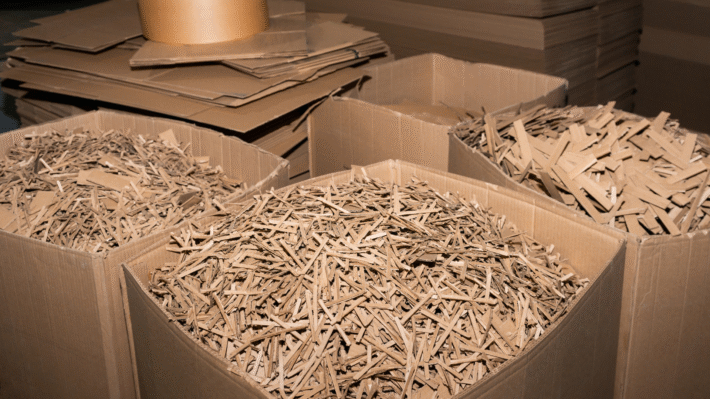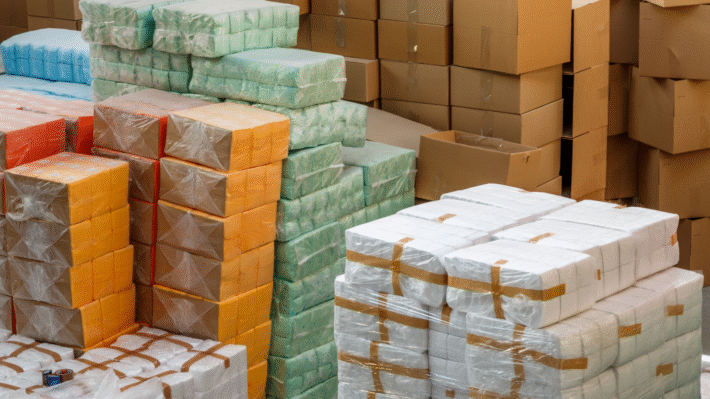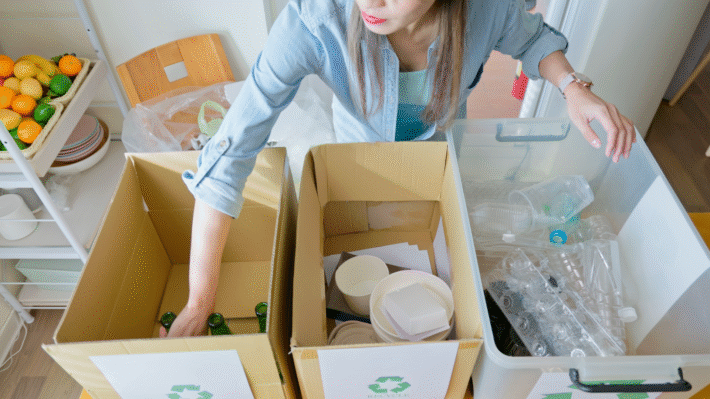Maximizing Reuse and Recycling to Keep Materials in Circulation

Imagine a world where everything, from soda cans to old computers, doesn’t just end up in a landfill but is given a second life. Welcome to the bright future of reuse and recycling! In this circular economy, we’re turning trash into treasure by keeping materials moving in endless loops rather than with a one-way ticket to disposal. It’s a super important task that helps our planet, our wallets, and ourselves.
With reuse principles, we repair and repurpose what’s old to make it as good as new. When recycling, materials like metals and plastic are recovered and reborn using clever methods. Even with challenges like logistics and contamination, we’re tackling them with innovative ideas like AI-aided sorting and enzyme recycling.
Are you excited to learn how you can join this movement and help maximize resource recovery? Let’s dive into the amazing world of reuse and recycling!
Understanding Circular Economy
The circular economy is a big idea that’s changing how we think about waste and resources. Instead of the old “take, make, dispose” way, it’s about keeping things in use for as long as we can.
Linear vs. Circular Models
How Linear Models Work
In a linear model, we start by taking materials from the earth. We use these materials to make things. After using them, we throw them away, and they often end up in landfills. This process uses a lot of natural resources and creates a lot of waste. It’s like when you use and throw away paper once, and then you cannot use it again.
Advantages of Circular Models
Circular models work differently. They focus on reducing waste. They do this by reusing, fixing, and recycling products. Imagine if your toys were broken, but instead of throwing them out, you fixed them or used them to make new toys. Circular models are good because they help the environment. They save resources and keep our earth cleaner by making sure less trash ends up in landfills. These models are smart because they help us keep using things without always needing new resources.
Importance of Reuse and Recycling
Maximizing Resource Recovery
When we talk about maximizing resource recovery, we mean getting back as much material as possible from things we no longer need. When something breaks, like an old bike, instead of tossing it, we take it apart. We save parts like metal and rubber to use again. This process saves valuable resources so we do not have to take more from our earth.
Reducing Waste with Reuse
Reducing waste with reuse is about finding new purposes for old things. Let’s say you have a shirt that no longer fits. Instead of throwing it out, you can make it into a pillow or a bag. Reusing items like this helps us make less trash. It shows us how to think creatively and wisely about the stuff we have. By reusing, we make sure that less waste piles up and we help our planet stay green and clean.
For more information on the circular economy, you can visit this resource for a deeper dive.
Benefits of Reuse and Recycling
Environmental Impact
Reducing Carbon Footprint
Reducing the carbon footprint is one big way reuse and recycling help the earth. When we recycle, we need less energy to make new things. This means using less fossil fuels, like coal and oil, that send out carbon dioxide into the air. By recycling metals, plastics, and paper, we can save lots of energy and make our earth cleaner. Learn more here reduction of carbon.
Decreasing Landfill Waste
When we talk about decreasing landfill waste, recycling and reuse come to the rescue. Every product we use and throw away adds to the big piles of trash we call landfills. When we reuse items or make new things from old ones, we keep these items from reaching the landfill. This gives us more space and helps plants and animals too. You can explore more about reducing waste in landfills here.
Economic Advantages
Job Creation Opportunities
Job creation opportunities are a benefit of recycling and reusing. The recycling industry needs people to collect, sort, and convert waste into new products. This means more jobs. It’s not just about saving the environment, but also about creating work for people who need it. Jobs like driving collection trucks, sorting recyclables, and processing materials are just some examples. Find out more about job opportunities in recycling here.
Boosting Local Economies
Boosting local economies happens when we recycle. Local recycling centers often bring in money and businesses. They need people to work, they buy local services and supplies, and even attract other companies related to recycling. This means more money and growth for local communities. Discover how recycling boosts local economies here.
Social Benefits
Educational Opportunities
Educational opportunities grow when we focus on reuse and recycling. Schools and communities can learn about why recycling is important. By teaching kids to recycle, we raise a new generation that cares about the planet. Recycling programs often have workshops and activities for everyone to join in and learn. Learn about educational programs on recycling here.
Community Engagement
When it comes to community engagement, reuse and recycling bring people together. Community recycling drives and events can get everyone involved. Working together makes neighborhoods stronger and teaches everyone the value of working towards a common goal. Read about community engagement through recycling here.
By understanding these benefits, we make choices that help the planet, boost the economy, and connect communities. Every small action counts when we all work for a better, cleaner world.
Principles of Reuse
Reuse is all about making the most out of items we already have. By focusing on repairing, refurbishing, and repurposing, we can give things a second life.
Repairing and Refurbishing
Repairing items means fixing things that are broken. Now, take your toy, for instance. If the wheel breaks, don’t throw it away! Fix it. Repairing helps people save money and keep stuff out of landfills. Would you believe that repair shops are everywhere? They mend everything from phones to fridges. By fixing stuff, we reduce waste and save lots of energy and resources.
Refurbishing goes further than just fixing. It makes things like-new again. A refurbished phone could look and work just like a brand new one. People save money and create less waste. This means good things for the planet too. Better yet, check out local repair cafes near you, where volunteers help people fix things for free.
Repurposing Materials
Repurposing is like changing an item’s job. An old t-shirt becomes a handy cleaning rag. Or, an empty coffee can turns into a plant pot. Repurposing helps us think creatively about items we no longer use.
This doesn’t just apply to homes. Businesses join in on the fun too. Some companies turn old materials into new products. Nike, for instance, uses old shoes to make new surfaces for running tracks Nike Reuse-A-Shoe Program. So next time, before tossing something out, think about how it could serve another purpose.
Remember, repair and repurpose are key principles of reuse that help save the planet one item at a time.
Types and Challenges of Reuse
Reuse is not just about using things again. It’s about finding new and smarter ways to give old items a second life. This helps keep materials in use longer and stops them from turning into waste. But, there can be some challenges too. Let’s take a closer look.
Direct Reuse
Direct reuse is simply about using an item as it is, without changing it. This can mean buying or selling items that have been used before, saving both money and resources.
Second-Hand Products
Second-hand products are what you buy when someone else doesn’t need them anymore. It’s like getting cool toys or clothes from a thrift store. Buying second-hand helps reduce the number of new things we need to make, which can save the Earth’s raw materials. You might find some treasures when shopping second-hand! It’s also a fun way to recycle Second-Hand Culture!
Industrial Reuse
Industrial reuse is when businesses find clever ways to use old materials. Instead of throwing materials away, they get a new purpose.
Upcycling Methods
Upcycling methods turn waste into better things. Imagine turning an old tire into a cool swing or a stylish planter. This is not just about recycling; it’s about adding value to things that might otherwise be considered trash. There’s a popular example where companies create beautiful bags from old banners and seatbelts. Upcycling can lead to innovation and creativity, transforming waste into something special. Check out these Upcycling projects.
Challenges Faced
Despite the benefits of reuse, there are some challenges that need to be tackled for it to work smoothly.
Behavioral Challenges
Behavioral challenges are about changing how people think. Sometimes, people just prefer new things, thinking they are better or cleaner. Teaching and encouraging people to see the value in used items is important. It’s about shifting habits to see the beauty and fun in reused items that are still perfectly good to use. Helping kids learn about reuse through environmental education.
Logistical Issues
Logistical issues are all about how we make the reuse process work well. Moving and sorting used items can be tricky. For example, getting second-hand products from one place to another, or even finding enough space to store them, can be a problem. Solutions include better sorting methods and finding more efficient ways to transport goods, which are crucial steps towards making reuse easier and more common in everyday life. Understanding the logistics behind waste management is important.
In the end, reuse gives new life to old things and helps save our world’s resources. While there are challenges, the benefits are huge for the environment, businesses, and our communities. Let’s push for more creative reuse methods and overcome the obstacles to make our world a better place to live.
Recycling Principles
Recycling Principles cover a lot of important ideas that help turn old stuff into new things. These ideas make sure we don’t waste stuff and keep our planet clean.
Recovering Materials
Recovering Materials is like finding treasures in our trash. When we recycle, we are not just throwing things away. We are saving materials like metal, plastic, and glass so they can be used again and again. This way, we don’t need to keep digging into the earth for new materials all the time. It’s like if you were able to get a brand-new toy just by fixing up your old toy instead of buying a new one. This is how we can make sure we use our resources wisely.
Methods of Recycling
There are many Methods of Recycling that help us turn used things into new products. Let’s dive into two main methods: Mechanical Recycling and Chemical and Biological Recycling.
Mechanical Recycling
Mechanical Recycling is like giving old materials a makeover. This method takes things like plastic bottles, metal cans, and paper, and grinds them up to make new goods. Imagine taking old paper and putting it through a magic machine that transforms it into new notebooks or magazines. Learn more about how mechanical recycling works here.
Chemical and Biological Recycling
Chemical and Biological Recycling is like science magic. It breaks down materials at a deeper level, turning them into their original building blocks. This is like taking a cake and breaking it down into flour, eggs, and sugar again. In chemical recycling, substances are treated with special chemicals, while biological recycling uses natural processes, like microbes, to break down organic waste. These methods are really cool because they allow us to create super clean raw materials. Discover more about chemical and biological recycling.
Remember, by learning about these methods, you can help make the world a greener place.
Challenges and Innovations in Recycling
Recycling is a big job, but it has its own set of challenges and innovations. Let’s explore what makes recycling both tough and exciting!
Addressing Contamination
One major challenge with recycling is contamination. This means that other stuff gets mixed in with recyclables, making it hard to use again. For example, leftover food or liquids can spoil good paper or plastic. To fix this, we need better sorting systems and more education to help people know what can be recycled. It’s like separating toys from your pet’s food – everything has its own place.
Market Demand for Recycled Materials
Another big challenge is the market demand for recycled materials. Companies need to want to buy these materials to make new products. If they don’t, all that recycling is wasted. Sometimes, recycled goods are more expensive or less pretty, so they aren’t used as much. To improve this, we need more companies to say, “Hey, we will use recycled stuff!” And folks need to support companies that do.
Innovative Technologies
Innovations are like cool tools that help solve hard problems. In recycling, there are some neat new tricks!
Artificial Intelligence in Sorting
Artificial Intelligence (AI) is like super-smart computers that help sort materials. They can look at fast-moving items on a conveyor belt and quickly decide where each belongs. It’s like having a robot friend who helps you tidy up your room super fast, without getting confused.
Enzyme-Based Recycling Innovations
Another fun concept is enzyme-based recycling. Enzymes are special proteins that can break down things naturally. New ways to use enzymes can help recycle plastics that don’t usually get a second chance. Imagine if you had a magic wand that turned broken toys back into brand-new ones! These enzymes help us get closer to that idea by recycling even more types of plastic.
By tackling these challenges and using cool innovations, we can make recycling work better for everyone. And guess what? It can help clean our planet too! If you’re curious about other cool projects and companies doing great things, check out sites like earth911.com for more info!
Roles of Corporations and Governments
Corporations and governments hold the key to unlocking a cleaner, greener future. Let’s dive into how they steer the ship on reuse and recycling.
Corporate Social Responsibility
Companies aren’t just about profit anymore. Today, they are stepping up to their social duties. They are realizing that being responsible is more than just a buzzword—it’s a must-do.
Many corporations now engage in programs that focus on cutting down waste. They are designing goods that are easier to reuse or recycle. For example, take a look at companies like Patagonia and their efforts to reclaim garments and encourage product longevity. By doing this, they are not just helping the environment. They are also winning the hearts of shoppers who care about the planet.
The idea is simple: make products last longer and keep materials in use. By doing so, companies can slash costs, spark innovation, and gain an edge over their rivals.
Government Policies and Initiatives
Governments have the authority to set the stage for a recycling revolution. Through policies and powerful decisions, they can create the right conditions for recycling and reuse to flourish.
Governments can impose laws like recycled content laws, which require new products to contain a certain amount of recycled material. This promotes a circular economy, where resources are consistently reused. The European Green Deal is a great example of a policy aiming to make Europe the world’s first climate-neutral continent by 2050.
Also, governments can provide tax breaks or financial aid to companies that invest in green technology. This not only convinces more companies to go green but also fuels economic growth.
By working together with corporations, educational institutions, and communities, governments can craft comprehensive strategies to crank up recycling rates. Collaborative efforts like this make the most of everyone’s strengths.
So, both companies and governments play a tremendous part in leading us to a future where reuse and recycling are just part of daily life. Let’s keep them accountable!
Future Strategies for Reuse and Recycling
To save our Earth, we need strong plans for reuse and recycling. Let’s explore how people, businesses, and countries can work together to make a big difference.
Individual and Business Strategies
Individuals can start by making small changes in their daily lives. Instead of throwing things away, try to think of clever ways to reuse them. For example, you can turn old jars into storage containers for your art supplies. It’s also important to buy products that are easy to recycle or are made from recycled materials. This way, you help keep the recycling loop going.
Businesses play an important role too. Companies can design products that are easier to take apart and recycle. Some businesses even offer repair services, so products last longer. This helps people save money and reduces the need to make new things from scratch. By sharing these practices, companies can inspire each other to become more eco-friendly.
Global Collaboration Efforts
The world is a big place, and solving recycling and reuse problems needs countries to work together. Global collaborations can create systems where resources are shared and not wasted. One good example is when countries join to make rules that stop throwing away too much and encourage recycling link here.
International meetings and partnerships allow nations to share ideas and learn from each other’s successes. Developing countries can get support from richer nations to set up their own recycling systems. Together, they can make smart choices about saving energy and resources, which benefits everyone on the planet.
By acting together, individuals, businesses, and countries can create a future where reuse and recycling are part of our everyday lives, helping to protect our environment for generations to come.



